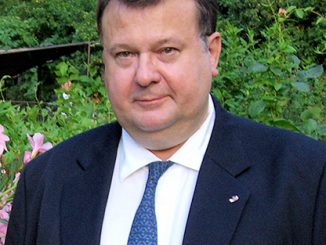Table of Contents
by Joël-François Dumont — Paris, August 10, 2025 —
I. The Evolving Media Landscape in the Digital Age: Global Trends
The global media landscape is undergoing a profound transformation, reshaped by rapid technological advancements and the omnipresence of digital platforms. Traditional print media faces a continuous decline in circulation, as evidenced by figures in France (-4.4% in 2023) and other parts of Europe and the United States.[2][3] Nevertheless, it persists in specific niches, such as among executives and high-income households in France, where 84.2% still read a print version, often complementing their digital consumption.[4] This « accumulation rather than substitution » phenomenon indicates a place for print media as a premium, in-depth reading experience.[3]
In parallel, digital news consumption is growing exponentially. In France, news websites record 67 million daily visits, primarily on mobile (20 billion annual visits), confirming the imperative for a mobile-first strategy.[2] However, this shift has undermined traditional economic models, with most digital advertising revenue often going to major platforms rather than publishers.[5]
The Growing Role of Social Networks and Podcasts
Social networks have become a major source of information. In the United States, over half of adults occasionally get news via these platforms, with Facebook and YouTube leading. TikTok is experiencing rapid growth for news, with particularly high engagement.[1][6] These platforms have democratized access to information, making it instant and personalized through AI.[7][9] However, this democratization comes with significant challenges: the proliferation of disinformation (58% of global respondents worry about distinguishing true from false)[1], issues of information veracity, and the impact on traditional journalism. Algorithms can create « filter bubbles, » limiting the diversity of viewpoints.[9] Furthermore, an erosion of trust in traditional media is observed among those under 30, who now trust social media news as much.[6]
News and analysis podcasts are also experiencing a notable boom. In France, 17.6 million monthly listeners tune in.[10] This format is particularly popular among young and educated audiences, offering a space for in-depth exploration and critical analysis of complex topics, sometimes marginalized by traditional media.[1][10] The willingness to pay for this type of content is significant, opening new monetization and integration opportunities for traditional media.[1]
II. Case Study: Ukrainian Media in Times of Total War
The conflict in Ukraine acutely illustrates these media dynamics. The war is also being fought on the information front. Since February 2022, Ukraine has implemented a unified information policy and increased control over its media environment, a measure accepted as necessary in times of existential war.[13] Restrictions imposed by martial law have allowed the government to regulate media, and journalists must be accredited to operate in war zones.[14][15]
In response, Russian disinformation is systematic, using diplomatic channels, social networks, state-controlled media (RT, Sputnik), and « troll factories. »[16] Its objectives are clear: to influence public opinion, exacerbate divisions, discredit Ukraine and the West, justify the invasion, and hinder international response. Tactics include denial, distortion, distraction, and alarm, extending to the impersonation of legitimate media.[16][17][18]
Regarding consumption habits, social networks remain the predominant source of information in Ukraine (73.4% usage), followed by the Internet (excluding social networks). TV, radio, and print media audiences have drastically declined.[19] General trust in information is low (only 11% of respondents report trusting most news most of the time), and most Ukrainians (80%) seek information from diverse sources to cross-reference facts.[20]
The resilience and adaptability of Ukrainian media are remarkable. The authorities’ communication strategy is coordinated, proactive, and skillfully leverages social networks, notably President Zelensky with his video selfies.[13][21] The « TikTok tactic » of Ukrainian soldiers, creating humorous or resistance videos, also illustrates this bottom-up innovation.[22] Independent local media benefit from crucial international financial support, particularly from UNESCO.[26] However, Ukrainian journalists face immense challenges: physical and digital risks, psychological burden, and loss of livelihoods, despite support from organizations.[26][27]
III. The European Response: The EUvsDisinfo.eu Initiative
In the face of systemic Russian and Chinese disinformation, Europe has asserted crucial leadership, not merely waiting for its allies to act. The creation of initiatives like EUvsDisinfo.eu in 2015 by the European External Action Service (EEAS) is a prime example. Where the Trump administration cut US counter-propaganda capabilities, the EU opted for a proactive approach.[4.1]
The Strengths of EUvsDisinfo.eu
The main strength of this platform lies in its rigorous debunking methodology and transparency. It not only refutes false information but analyzes tactics, recurring narratives, and sources, providing concrete evidence. It has meticulously documented Russian narratives aimed at discrediting Ukraine and sowing discord within NATO and the EU, exposing tactics of distortion or media impersonation.[16][17]
EUvsDisinfo.eu also excels at identifying the Sino-Russian convergence in information manipulation operations, showing how Beijing and Moscow share objectives to weaken Western democracies.[5.2] It highlights how China fills informational voids left by Western actors, particularly in Africa and Latin America.[2.1][5.4]
Furthermore, the platform plays a fundamental educational role. By making a database of disinformation accessible to the public (over 16,000 documented examples), it contributes to strengthening media literacy and raising public awareness of threats. Its role in coordinating among EU member states and its international collaborations also enhance its relevance and global effectiveness.
Persistent Limitations and Challenges
Despite its undeniable successes, EUvsDisinfo.eu and, more broadly, the European initiative against disinformation, are not without challenges. The primary one is the difficulty in reversing already entrenched perceptions; simple debunking, even when based on irrefutable evidence, is often insufficient to dismantle « filter bubbles » where false information thrives.[9] The scope and scale of disinformation operations, which are massive and constantly evolving, pose an immense challenge. The emergence of technologies like generative AI and « deepfakes » further complicates the task of refutation. The platform must constantly adapt to these new tactics.
Finally, there is always a delicate tension between combating disinformation and concerns about freedom of expression. Critics can accuse any attempt to control the flow of information of « censorship, » which is exploited by authoritarian regimes to undermine the legitimacy of democratic efforts. The allocated resources, while significant, may seem modest compared to the colossal budgets deployed by Russia and China for their influence operations. The fight against disinformation is a long-term battle requiring continuous investment and agile adaptation to remain effective.
Conclusion
The analysis of global media trends and the Ukrainian case study reveals that digital media is not merely replacing print media but contributes to the emergence of a complex, multi-platform media ecosystem. Print media, although facing a generalized decline in circulation, maintains its relevance in specific niches, particularly among high-income audiences and executives, who often adopt dual consumption, valuing both the print format for its depth and digital formats for their immediacy. This persistence suggests that print media can find its place by positioning itself as a premium and complementary reading experience.
In parallel, social networks and podcasts have gained a predominant role as sources of information. Social networks, with their ability to democratize information dissemination and offer real-time access, have become essential channels, especially for younger generations. However, this democratization comes with significant challenges, including the proliferation of disinformation and the difficulty of verifying facts, exacerbating public concerns about the reliability of online information. Sophisticated algorithms that personalize content risk creating « filter bubbles, » limiting exposure to diverse perspectives and threatening enlightened public discourse. Podcasts, on the other hand, stand out for their ability to offer in-depth information and critical analysis, meeting a need for immersion and a more nuanced understanding of complex topics. Their growing popularity, particularly among young and educated audiences, opens new avenues for monetization and integration for traditional media.
The case study of Ukraine in total war illustrates an extreme acceleration of these digital trends. The conflict has transformed the Ukrainian media landscape into an information battlefield where the proactive communication strategy of the authorities, combining mastery of social networks and emotional appeal, plays a crucial role. The Ukrainian population has massively turned to social networks and the Internet for real-time information, although general trust in media remains low and fragmented. Faced with systematic Russian disinformation, the resilience of Ukrainian media, supported by financial aid and international training, is essential to maintain a flow of reliable and independent information, despite the immense physical and psychological risks faced by journalists.
In summary, the current media landscape is a dynamic ecosystem where traditional and digital forms coexist and influence each other. The ability of media to adapt to new consumption habits, innovate in formats and economic models, and combat disinformation is decisive for their survival and for the vitality of public debate. The Ukrainian case underscores the critical importance of media resilience, support for independent journalism, and strengthened media education to enable citizens to navigate an increasingly complex and contested information environment.
Sources :
[01] Reuters Institute. Digital News Report 2024.
[02] ACPM. Les Chiffres Clés de la Presse 2023.
[03] Analysis of historical and economic media trends
[04] ACPM. L’audience de la presse auprès des CSP+ et des hauts revenus en 2024.
[05] DataReportal. Digital 2024 Global Overview Report.
[06] Pew Research Center. Social Media News Consumption 2024 (Février 2024).
[07] Study on the impact of social media on the dissemination of information and misinformation. Interview with the author.
[08] Report on user privacy and data security on social networks. Various studies on online privacy.
[09] Analysis of AI algorithms and their impact on content personalization and filter bubbles. Reflection on artificial intelligence and information.
[10] Médiamétrie. Les podcasts, plus de 17 millions d’écouteurs mensuels en France (December 2023).
[11] Research on podcasts and critical thinking: Studies on the cognitive impact of the media. Interviews with the author.
[12] Analysis of podcast promotion strategies by the French press. (Source: Observation of editorial practices).
[13] Desk Russie : Entre liberté et censure : les médias ukrainiens en temps de guerre totale (6 juillet 2025).
[14] Reporters sans frontières (RSF). Informations sur les restrictions des médias en Ukraine en temps de guerre.
[15] Reports on the safety and protection of journalists in conflict zones.
[16] EU vs Disinfo. « Désinformation et propagande du Kremlin : Cas et tactiques ».
[17] Analysis of Russian disinformation operations and media impersonation. (Information warfare). Sources: Brussels, Prague & Paris.
[18] Étude sur la création de pseudo-médias par la Russie. Étude gouvernementale sur la désinformation étatique).
[19] Internews. « Media Consumption and Trust in Ukraine » : (Annual Reports).
[20] Internews. « Media Consumption and Trust in Ukraine »
[21] Analysis of the Ukrainian government’s communication strategy during wartime. Interview with the author).
[22] Various press articles on ‘tactical TikTok’ and the use of social media by Ukrainian soldiers.
[23] Reports on the adaptation of public broadcasters to coverage of the conflict in Ukraine: Studies on European media.
[24] International Media Support (IMS). « Souutien aux médias locaux et indépendants en Ukraine.»
[25] Reports on training journalists to cover war justice in Ukraine.
[26] UNESCO. Aide d’urgence aux médias en Ukraine : l’UNESCO soutient plus de 1000 journalistes» (Février 2024).
[27] Comité pour la protection des journalistes : Ressources et soutien pour les journalistes en zone de conflit. (CPJ), ACOS Alliance, Reporters sans frontières (RSF), Rory Peck Trust & Dart Center for Journalism and Trauma.











